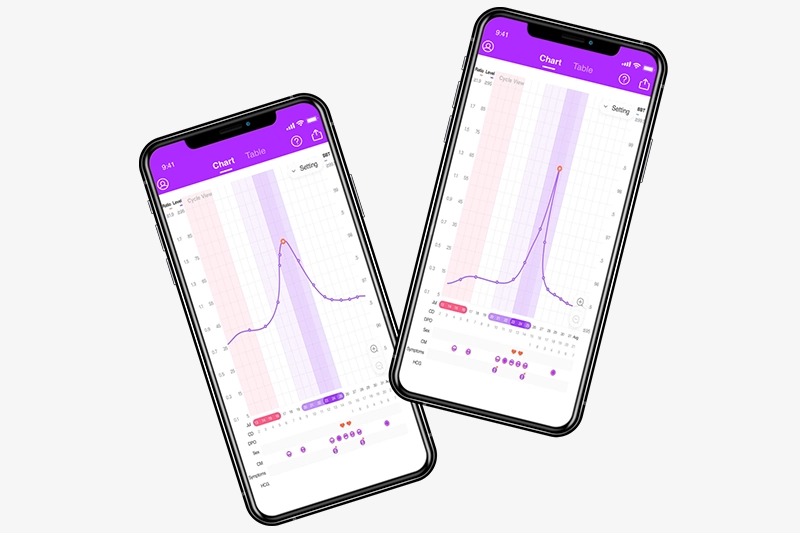We know testing your luteinizing hormone levels and testing for ovulation daily, especially when you have long cycles, can get tiring. We also know that when it comes to charting for fertility, things get complicated fast. It’s easy to feel lost when faced with LH testing, basal body temperature readings, and cervical mucus observation.
Know that you aren’t alone!
Many women who are trying to conceive find this process a bit daunting. But stay strong because the daily practices of tracking and charting provide valuable information about how your body operates and your LH charts and ovulation charts can give you the fertility or infertility information you need.
If you’ve ever wondered how your charts compare to normal charts, average charts, or even abnormal charts, you’re in luck. This article walks you through LH chart examples and ovulation chart examples you can use to better understand your cycle data.
Tracking Your LH Levels
If you’ve read our articles on getting pregnant fast, then you understand how important tracking your LH levels can be when trying to conceive — and there can be a great deal of variances in LH patterns, some of which can indicate an issue, or at least an obstacle, to conception.
The two normal patterns of LH surges are gradual onset LH peak and rapid onset LH peak.
- A gradual LH surge pattern will slowly rise over 1-6 days of your cycle.
- A rapid LH surge pattern will quickly rise in just one day.
When women were studied, it was found that 57.1% had a gradual onset greater than one day, and 42.9% of women had a rapid onset. Let’s look at a few charts and see how this affects testing and conception.
Rapid LH Surge Chart Example
When you look at the chart below, you can see several days of LH (luteinizing hormone) testing without much rise and fall. However, on cycle day 13 (CD 13) there was an enormous spike in LH levels.
Ideally, a woman with this surge pattern would track LH levels every day during the predicted fertile window, and possibly sooner. For women with a rapid onset LH surge, missing a day of tracking could mean a missed peak. If they’re not careful, they may not know ovulation occurred until a basal body temperature (BBT) rise afterward confirms it.
If you haven’t found an LH peak, it may be a good idea to test twice daily for 1-2 cycles to ensure you’re not missing a rapid rise!
Also visible in this chart example is the timing of intercourse, which was timed appropriately for peak day and ovulation day — CD13 and CD14. Sexual activity should be targeted throughout the fertile window (seen in purple). In this example that would include CD9-CD15, which includes the day after suspected ovulation on CD14.
While the example shows some appropriately timed fertile cervical mucus (CM), unfortunately, there is no basal body temperature tracking included, so it would be difficult to know if the LH peak truly resulted in successful ovulation.
Gradual LH Surge Chart Example
A gradual LH surge is the most commonly referenced cycle pattern. The sample gradual surge chart below is a great example of daily tracking to ensure the surge is not missed. You can see that the LH levels do bob up and down at a low level for a few days, then gradually begin a steady increase in CD 11-CD 13. You’ll also notice that on CD14, CD15, and CD16, the LH levels have lowered again, which means you can feel confident a peak has been found.
This example also includes intercourse on ovulation day and the day before, but it would be more effective to have intercourse well before the LH peak, starting on CD9. Having sperm present before your peak day helps ensure your chances of conception.
Additionally, an odd observation about this example chart is that no fertile mucus was noted before the LH peak. If the fertile mucus was absent, it could signal an issue with the follicular phase, even with an LH peak present. BBT and PdG tracking could confirm ovulation and hCG tracking would confirm pregnancy.
What If My LH Surge Doesn’t Fit These Patterns?
If your LH surge doesn’t seem to fit either of the above patterns — gradual LH surge or rapid LH surge — it may look like the example chart below.
At first glance, this chart may not look abnormal, but it does highlight some issues with LH. You can see the LH was tested every day to ensure a peak was not missed, however, you can also see that there wasn’t one significant LH peak day. On CD13 and CD15 there are little mini peaks, but nothing monumental.
While rare, there is a slight chance this user was very overhydrated on her peak days, and the LH sample was diluted so significantly that it made LH levels appear lower than they were. This is a great reminder to keep your water intake consistent daily so that samples aren’t ultra-concentrated one day and super diluted another day.
In these cases, adding BBT tracking is always helpful, as a spike in BBT could confirm ovulation. While there is no perfect LH level to trigger ovulation, the pattern of this chart indicates an unlikelihood of sufficient LH activity to trigger ovulation.
If your chart looks like this, it may be worth a conversation with one of our fertility specialists in a Premom virtual fertility consultation. Check your Premom app to see all of the options available.
Tracking Charts Can Highlight Fertility and Infertility
Both of the charts shown above demonstrate the positive practice of consistent testing! Even with minor peaks, ovulation testing continued to ensure a late LH surge was not missed. Just as we walked you through those charts, we’re going to take a look at some sample ovulation charts so you can:
- See how your chart compares to a “normal” cycle chart or if your cycle looks more similar to someone with PCOS or with short cycles.
- See examples of good cycle tracking and charts that show promising results for ovulation, intercourse timing, and chances of conception.
- Learn what makes for an idyllic conception cycle and review some common irregular chart patterns.
Normal Menstrual Cycle Chart Example
There really is no such thing as a normal menstrual cycle. We can, however, identify what the average patterns look like that most often result in successful conception. If your cycle doesn’t match the average exactly, it doesn’t mean you can’t get pregnant. It means you may have some unique variances that should be continuously monitored to optimize fertility.
- Average cycle length tends to be between 21-35 days.
- LH (luteinizing hormone) tends to surge between days 10-16 on average and is where the most variance in cycle length typically exists.
- The luteal phase, or the second half of the menstrual cycle after ovulation, is more consistent among women and is typically around 11-16 days long.
The example chart below shows a 32-day cycle with a 13-day luteal phase, which tells us there would have been plenty of time for implantation of a fertilized embryo if trying to conceive. You can see that ovulation tests have been tracked every day, which is particularly important because of the abrupt rise in LH. If you have a chart that looks like this, it’s easy to miss your peak if you’re not diligently tracking.
Another thing that makes this cycle example gorgeous is the intercourse timing, which occurred before ovulation. With sexual activity timed as LH is rising, a woman can feel confident that sperm are present during ovulation.
The basal body temperature tracking is also very clear and consistent. This is important because it helps confirm ovulation occurred. If ovulation had not occurred, a woman would not be producing the hormone progesterone that makes your body temperature rise in the luteal phase.
The last detail to look at on this chart is the frequency of cervical mucus tracking. A close record of cervical mucus can further be confirmed with the presence of egg white fertile mucus, just before and during ovulation.
If you have a cycle similar to this example and did not get pregnant while trying to conceive, know that you did all the right things in cycle mapping, tracking, and intercourse timing. It could be that a non-hormonal IUD or protection was used, or simply conception did not occur during this particular cycle for unknown reasons.
Remember, if you’re younger than 35, you only have a 25-30% chance of conceiving each cycle in perfect conditions, so it’s important to stay consistent with your tracking each month!
Abnormal Ovulation Chart Examples
Now that you know what an outwardly idyllic cycle looks like, let’s take a look at abnormal cycle chart examples.
The sample chart below demonstrates a fantastic job tracking LH levels and BBT and adequate intercourse timing. You can see an LH peak, which seems promising, but when you take a closer look, there are some underlying issues.
Although you see an LH peak and a period 12 days later, there isn’t a significant thermal shift in the luteal phase of the cycle. This minimal increase in BBT makes us suspect that although LH peaked, ovulation may have not occurred. This may mean that for some reason the brain and ovaries weren’t communicating well. The brain is secreting luteinizing hormone (LH) telling the ovaries to ovulate, but the egg may have not actually been released this cycle.
Negative results for progesterone test strips this cycle would further confirm our suspicion that there was no ovulation.
Pregnancy tests are also included and hCG testing is shown in the chart to start just 4 days past suspected ovulation, but typically hCG levels are not detected until about 10-12 days post ovulation.
Why is that? Could it be PCOS or hypothyroidism?
This cycle, lasting 70 days, was extraordinarily long. Often this cycle pattern signals PCOS or an undermanaged thyroid issue. So, while it is essential to continue tracking cycles in this example, some dietary changes — and perhaps investigation of hormone levels with a medical provider — might also be recommended. A good next step would be scheduling a virtual consultation through the Premom app with a fertility expert!
Short Luteal Phase: Luteal Phase Deficiency Chart Example
This chart shows abnormal BBT fluctuations, which could be related to female sex hormone irregularities or thyroid issues, so it’s difficult to determine if ovulation occurred. Equally important is the presence of luteal phase deficiency.
When looking at the portion of the cycle between the purple and the red, you see the period begins just 5 days after suspected ovulation. This can be problematic when trying to conceive, as the inflammatory cascade that initiates your period triggers a couple of days before your period actually begins. A luteal phase that is less than 10 days long doesn’t provide enough time for a fertilized egg to properly implant before the menstrual cascade begins.
If this example sounds like you, consider speaking with your doctor to check your progesterone levels or discuss fertility options. Integrative physicians often recommend herbs such as Vitex or seed cycling in hopes of lengthening your cycles.
Have Questions About Your Ovulation Chart? Premom Can Help
Hopefully, these example charts have helped you better read your charts and understand the signs and symptoms of fertility and infertility.
If you have questions about your chart, you can book a virtual consultation with a fertility specialist and get the answers you need right in the Premom app. Our specialists are standing by and waiting to speak with you.
References
- https://www.ncbi.nlm.nih.gov/books/NBK279054/
- https://www.shadygrovefertility.com/blog/fertility-health/the-most-common-cause-of-female-infertility-problems-ovulation
- https://www.todaysparent.com/getting-pregnant/trying-to-conceive/what-are-your-odds-of-getting-pregnant-each-month
- https://www.ncbi.nlm.nih.gov/pmc/articles/PMC4037737/
- Su HW, Yi YC, Wei TY, Chang TC, Cheng CM. Detection of ovulation, a review of currently available methods. Bioeng Transl Med. 2017 May 16;2(3):238-246. doi: 10.1002/btm2.10058. PMID: 29313033; PMCID: PMC5689497.



